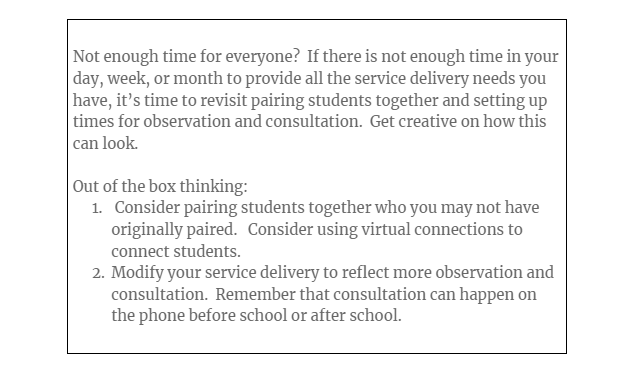The Itinerant Teacher - a Slave to her Schedule
Sep 06, 2021
When I started as an itinerant teacher my schedule was awful. I felt scattered all the time. I was literally driving in circles every week with more windshield time than time with my students. I had students I would drive more than an hour to see, so that I could spend 30 minutes with them. Is your schedule crazy like this?
I was frustrated. I felt unorganized and unbalanced.

I finally recognized that my schedule was controlling me. I needed to turn things around so that I controlled it.
Having domain over my schedule and having ongoing, easily accessible, materials at my fingertips for all students lightened my load and completely changed how I delivered services - and increased the impact I had.
Let me give you the 5 steps I took, and you can take, to control of your schedule.
5 STEPS TO TAKE DOMAIN OF YOUR SCHEDULE:
- Group kids in a similar area on the same day
- Schedule high school students first, then block the others in
- Work with students together when possible
- Leave plenty of room between visits
- Block off time for observations and consultations
The first thing you need to do is create a spreadsheet of all your students and their required IEP time.
Take a pad of sticky notes. Each direct service time needs to be represented on a single sticky note.

If you see a student three times a week for 30 minutes, then you need 12 sticky notes (one for each direct service time during the month) to represent a month’s worth of service.
Now for each service time provided to each student, write the name of the student, the school and the amount of time.
Now find a wall or a table that you can lay all the stickies out on. You will use this as a rough grid.
Step one: GROUP KIDS IN A SIMILAR AREA IN ONE DAY.
If you see multiple kids in the same school, it makes sense to see them all on the same day. If you have two districts close to each other, work to see those students on the same day.
I know, it seems like common sense but oftentimes it doesn’t work out this way .
Sometimes schools request certain days or times that would require you to come when it is really not convenient. Many Teachers of the Deaf and Hard of Hearing make accommodations for this.
It’s okay for you to stick to your own schedule. Accommodating others is good, but you must give yourself limits on what you can and can’t do. We’ll address this further in a minute.
At first, I was nervous to give schools my schedule and when I was available to work with students. I was surprised to see that most of the time they were willing to work with me. As soon as I did this, I was able to quit driving in circles. This was huge in reducing the time I spent driving in circles, back and forth to districts and schools.
Now, using a table, make 5 piles; one for each day of the school week.
Decide what days you’ll go to what schools, and put each student's stickie in a pile for that day. Remember to group schools within close proximity on the same day. Don’t worry about the times yet.
At this point you have your days and schools slotted.
We will work on times and weeks next.
STEP TWO: SCHEDULE HIGH SCHOOL STUDENTS FIRST.
When it comes to actually scheduling your students, start with your high school students. They have the least amount of flexibility and it is important to not pull them from any academic classes.
Find out when they have a study hall or a non-academic time slot. Schedule them during that time. If they have academic classes all day, you may have to get creative about scheduling.
Now do the same thing with your Jr. High/Middle School students.
Now that the secondary students have a potential time slot, take the sticky notes with the primary and early childhood students you have slotted for the day and try to determine if you want/need to see them BEFORE or AFTER the secondary students. Again, you don’t need any specific times yet. Also don’t worry about weeks. For now we are focusing on DAYS and potential ORDER of students. Using the table or wall you used in the first step, chart out this information.
After you complete this exercise, you will tentatively know
- what students you will see what days
- when you will tentatively work with your secondary students
- if you will see the elementary students before or after the secondary students.
STEP THREE: WORK WITH STUDENTS TOGETHER WHEN POSSIBLE.
Research shows that DHH students have a 25% higher incidence of loneliness.
One way to help prevent these feelings is to give students opportunities to connect with other students with hearing loss.
Do you have any situations where you can pair multiple students together?
Do you have opportunities to pair older students with younger students?
Consider the following:
- Multiple students in the same building
- A student at a different school who might have access to another adult, such as an interpreter, to help support a virtual connection, such as through Zoom or FaceTime.
These pairs may or may not be appropriate all the time, but can be beneficial to all involved when you can do it some of the time.
What would you do during these times? Play games, practice talking about hearing loss, interview each other, and talk about big events. You can incorporate many IEP goals into these activities.
Research shows that connecting DHH students to other DHH students helps
- Increase social self-concept
- Increase confidence
- Encourage social behavior

Pairing students together also gives you more time in your schedule to collaborate with others, make observations and build capacity within the staff working with your students.
Okay, now that you are thinking about students that can be paired together, look at your current grid. Pair the sticky notes of the students that you can service together.
If you service a student once a week that means you have 4 sticky notes for that student for the month. If you are pairing him with another student 1 time a month, just pair 1 sticky note. If you are pairing him every time, you will pair each of the 4 sticky notes.
Make sense?
At this point, you should have
- The days of the week lined up
- An idea of students that you might pair
- An estimated “order” of who you will see on what day of the week
Now it’s time to draft a schedule.
You need a chart. Make 4 tables with 5 columns each. Each table represents one week of the month.
WEEK 1:

WEEK 2:

WEEK 3:

WEEK 4:

Plug students in as you have them drafted. The only times you really need at this point are the secondary students. Remember to pair students on your schedule as you determined possible.
After you have finished your drafted chart, contact the elementary school teachers to identify exact times on your day. Also connect with the SLPs and your audiologist to help coordinate times. Determine your LIMITED FLEXIBILITY. Remember that it is likely that you have the least flexibility of everyone working with your student. Do not feel that you need to modify your entire schedule to accommodate other people’s schedules. It is often easier for others to accommodate YOUR schedule than for you to try to accommodate theirs. It’s okay to have a few options and stick to them.
STEP FOUR: BLOCK OFF TIME FOR OBSERVATIONS AND CONSULTATIONS
Do you have time for observations and consultations built into your schedule?
If you don’t, I encourage you to start adding this to your IEPs as they come up. Subtract a few service times a year for each student you have and replace it with time for observation and consultation. These observations will give you a real world picture of a student’s generalized skills and needs. This has been a huge game changer in how I am able to deliver services, maximize my impact, and connect with the general education teachers that work with my students.
Time for consultation is imperative for other staff to understand the needs of your DHH students and to partner with you in working toward, and generalizing, skills.
STEP FIVE: LEAVE PLENTY OF ROOM BETWEEN VISITS
As you are looking at your schedule, make sure you leave plenty of extra time for those days that you experience bad weather, need to get gas, or need to chat with additional staff before you leave.

A note about Virtual Learning:
The Covid Pandemic in 2020 completely changed how we deliver services to our students. It threw people into the virtual arena. Although this was an uncomfortable change, it opened up new ways to connect with students, create interaction, and allows others to connect with each other. If Virtual Learning is an option for you to see students, incorporate this into your schedule. It especially works well with high school students. Utilizing virtual services can connect students with others anywhere. You can even collaborate with students outside of your caseload and team with others. Consider this opportunity as you are setting mastering your schedule and working with your DHH students.
Maximizing your drive time, cutting back on driving in circles, grouping students together, and modifying your service time to include observations, as well as opening up virtual opportunities when possible will completely change how you deliver services and will maximize your impact.
Give it a try - one step at a time and comment below how it’s changing how you deliver services.


